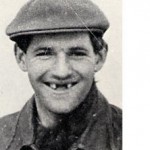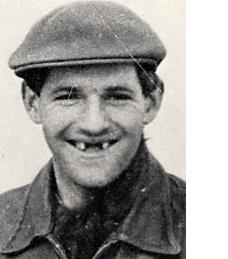The poor old farmers took a pounding. A large acreage of peas near my home that were coming into bloom were laid flat. Still growing, they will be a hell of a job to combine come harvest. Never a high growing crop, this year’s is even lower, kneeling in fact on the earth.

With each passing low pressure, the weather charts show another hard on its heels roaring out of the west across the Atlantic. I really think that this year we have had our summer; the nights are drawing in and nature cannot wait; she has to sleep. The other day a news item on the telly said that this June had been the warmest since 1976. Well it wasn’t around here! We still had a blanket on the bed and the dogs still came under the sheets.
I think I will take the two fly swats back to Dennis’s in the High Street and get a refund. Flies and mosquitoes are in short supply. Like the cuckoo this year, they are noticeable by their absence. Mr Cuckoo paid only a fleeting visit, seldom calling on the marsh, hiding in the woods out of the wind and rain. The lawn’s growth has slowed down even with all the rain it is getting. Tomatoes will not ripen as in other years. Lettuces bolt to set seed before the frosts comes to kill them; they have had enough this year
Shoals of mackerel did not show along the shore until mid-July, the first time in living memory. June usually sees the sea boil with the shoals. The fishermen in Norfolk have reported that prawns, rare visitors a few years ago, are now so plentiful that they are catching them in commercial numbers.
England’s weather has gone mad. Are we going to have an Indian summer? That’s anyone’s guess; ask the experts and they will tell you that there are no signs of it yet. The jet streams high above earth that the birds migrate in sets our weather patterns for the year. This year it is further south so allowing the lows to run over the top of Britain. Consequently this summer has been a washout. The eastern part of our little domain is now the well-known Rye Harbour Nature Reserve. That is a laugh! To start with, there are now fewer birds there for the twitchers to see than when we were kids. Two things in my mind have changed it from all recognition, since they took over the running of the place.
The very first thing was for them to ban all the sheep, as they might walk and damage the bird’s nest and eggs. What a mistake! Have you not seen the wildlife films on TV where a small bird protects its nest from a beast as large as an elephant? They spread their wings and make such a noise. Also the sheep ate anything resembling grass that dared to show above the ground and the more they ate, the more came out of the other end. This sheep dung was the host of thousands of little bugs and beetles, which the little birds used to peck over and use it to feed their offspring. With that gone, along with the sheep, the large sweeps of beach, placed in drifts as the sea retreated from Rye hundreds of years ago, started to grow long grass and today it looks more like the Canadian Prairies than open beach.
The landscape has changed. Bramble and thorn, along with gorse, now dot the area. Among these are large gravel pits that were being dug in the fifties and sixties. These teemed with terns and pochard. The diving birds left as they stopped digging. I think they loved the stirred up water from the large pumps that sucked the shingle up into barges. The islands that were left as no good to dig, were the sites of the nesting birds. Us lads would visit these in the winter, and set fire to burn off all the old dead grass. Then later on, when nesting was underway, we plundered the eggs until the middle of April, sending them to London for the noble rich to eat for breakfast. Consequently the birds never hatched a chick until mid May and then the weather was warmer and a lot more conducive to brood rearing than a cold April day.
The little Kentish Plover thrived out on the clear open beach; it could see what was going on around it as it sat on its nest. Now the grass is so tall, it is blind and does not come in vast numbers. Magpies, crows and foxes thrive on areas like this where no one kills them. In my youth, they had a price on their heads and we cashed in on it. Alas a Warden is not allowed to kill birds or take their eggs, so the kestrels and vermin have a free meal.
Go anywhere or visit the web site and you will find the RHNR there. So “Come on down, crowd the place out with your parties of bird watchers.” In my day, hardly anyone knew it existed. Today they come in busloads and with more rights to ramble. How can you stop them? A reserve for birds should be a place for birds, not a spectacle for people; or re-name it “Spot the odd bird!”
In the late sixties a book came out called ‘Silent Spring.’ We were all warned that the way we were going, we would have a disaster. Well it’s happening now. Not quite as the book told us, but slowly we are killing everything with pollution and chemicals. The wild birds are not dying now from DDT, but the bugs are from a drug. The farmer has altered his way of farming. Now it is a large industry. No more are there mixed farms; they are large, very large. In my day, there were hundreds of different people owning areas of twenty to two hundred acres of land. They have mostly gone and, with their disappearance, the old characters have gone as well. Billions of pounds a year are given away in subsidies and who gets most? I can tell you. Four fifths go to the huge farms to grow more corn. The government pay huge subsidies to the corn barons from the EC. The little farmer gets one fifth and he has a mixed farm and uses less spray. Today MAFF will send out a warning about a certain pest, so all the corn is sprayed with a bug killer. This does not hurt us, so they say, but only the bugs. But these small insignificant little devils are the bread and butter of so many of the birds we used to have in abundance.
The skylark is fast vanishing because sheep are given a shot of something to guard against this or that, no matter that they are healthy; maybe they will get it! To my mind it is a lazy way to farm. In the past the shepherd walked his sheep and dealt with things when it first showed. All farmers knew the number of animals per field and counted them daily. Now a lot of men have no idea exactly, unless they consult their electric wizard in the office. The sheep droppings contain a small amount of the drug forced down their throats and it kills the bugs and bacteria, so the birds have less to feed on. The corn boys are the same. Everything is by the ton, not sacks. The sparrow is a bird that used to eat a whole combine width of corn around the field. Now you have to look for a ‘spagger.’ No longer are their clouds of them.
The corn bunting seems to be scarce now as well, and I have not seen a pair of turtledoves for years. The collared dove drove them out, just like the grey squirrel did to the natural red. These chemicals are not good. ‘Round up’ is a very good herbicide in the right hands, but the corn barons use it after the combine, to kill everything before the plough goes in. It was always later that the stubbles were turned in, and the partridge and his friends had time to pick the earth over for lost corn, weed seeds and grubs. There is no rotation now; it’s all plough, cut, plough. No time to watch the world go by. Fifty acres a day, all done!
From Rye’s Own August 2004
All articles, photographs and drawings on this web site are World Copyright Protected. No reproduction for publication without prior arrangement
